

Uk.businessinsider. Silence your inner critic: How to be more confident at work (and why your boss will thank you) 19 Traits of Bad Bosses. As well as a sequel.

Listen in on conversations at a happy hour on any given Friday, and you will hear all about them. Bad bosses can be found at every level of management, and they often display the same characteristics. In nearly all of my leadership development workshops, after explaining the importance of the manager-employee relationship in improving employee engagement, I challenge the participants to become someone’s “best boss.” High-performing teams: A timeless leadership topic. CEOs and senior executives can employ proven techniques to create top-team performance.
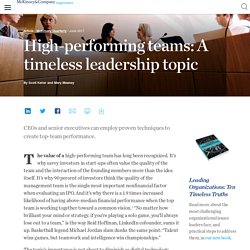
The value of a high-performing team has long been recognized. It’s why savvy investors in start-ups often value the quality of the team and the interaction of the founding members more than the idea itself. It’s why 90 percent of investors think the quality of the management team is the single most important nonfinancial factor when evaluating an IPO. And it’s why there is a 1.9 times increased likelihood of having above-median financial performance when the top team is working together toward a common vision. Why effective leaders must manage up, down, and sideways. Strong team leadership isn’t enough.

New research shows the importance—for business impact and career success—of also mobilizing your boss and colleagues. Most of the leadership advice aimed at senior functional managers is how to build, align, energize, and guide a world-class team. This is a challenging task in its own right, but we all know it isn’t the whole story. Leaders, even those in the C-suite, must also extend their influence upward and horizontally. The hidden toll of workplace incivility. Research shows that hurtful workplace behavior can depress performance, increase employee turnover, and even mar customer relationships.
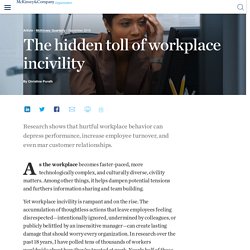
As the workplace becomes faster-paced, more technologically complex, and culturally diverse, civility matters. Among other things, it helps dampen potential tensions and furthers information sharing and team building. 25269 3 reasons high performers resign and how to prevent it. Should Performance Reviews Be Fired? “Performance reviews.”
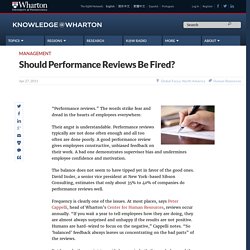
The words strike fear and dread in the hearts of employees everywhere. Their angst is understandable. Performance reviews typically are not done often enough and all too often are done poorly. A good performance review gives employees constructive, unbiased feedback on their work. Knowledge.wharton.upenn. When it comes to workplace events that produce resentment and anxiety, few score higher than the big annual performance review. Infographic: Giving Feedback 101 For Managers & Leaders — Sales Development & Leadership Programs. “Employee Engagement” continues to be all the rage in HR circles with several hundred million dollars a year being spent on internal and external programs.
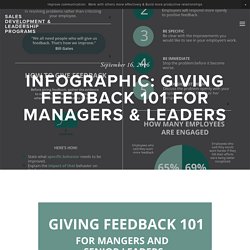
It’s a Huge investment for a situation in which the jury remains out on defining what is meant by engagement and what organizations are really getting for these astronomical investments. It looks like a piece of this puzzle can be solved at far less cost and deeper within the ranks. Recent research indicates that direct management feedback given in the proper context makes for happier and more satisfied employees who are likely to be more productive or “engaged”. However, it can be an untapped training and development tool because many leaders either don’t understand how to give comments that are constructive or don’t do it all. The latter often stems from a fear of conflict or having “difficult conversations”.
Critical to productive feedback is having the listener feel good about it. Infographic: New Managers Not Getting the Training They Need to Succeed. In a recent survey conducted by The Ken Blanchard Companies, more than 400 managers were asked to rate different types of training by order of importance.
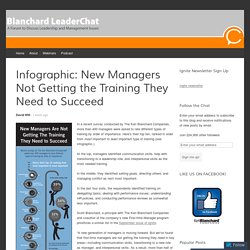
Here’s their top ten, ranked in order from most important to least important type of training (see infographic.) At the top, managers identified communication skills, help with transitioning to a leadership role, and interpersonal skills as the most needed training. In the middle, they identified setting goals, directing others, and managing conflict as next most important. Forbes Welcome. 20 tips to improve employee engagement and performance. High levels of employee engagement in an organization are linked to superior business performance, including increased profitability, productivity, employee retention, customer metrics and safety levels.

That’s way we all want employees to be engaged at work, right? But how can we actually get there? Talkline – Blind Date – Employee engagement and performance Here are 20 tips: #1 – Communicate clear goals and expectations to your employees. How Often Is Too Often with Continuous Feedback? The science is in, it’s been proven, and continuous feedback is the way of the future when it comes to performance management.

Continuous feedback has a positive effect on employee engagement, retention, performance, and a laundry list of other benefits. But this discovery leads us to a question: How often is ‘continuous’? Weekly? Daily? People analytics reveals three things HR may be getting wrong. More sophisticated analyses of big data are helping companies identify, recruit, and reward the best personnel.

The results can run counter to common wisdom. Bill James, the factory watchman turned baseball historian and statistician, once observed, “There will always be people who are ahead of the curve, and people who are behind the curve. But knowledge moves the curve.” Ahead of the curve: The future of performance management. What happens after companies jettison traditional year-end evaluations? The worst-kept secret in companies has long been the fact that the yearly ritual of evaluating (and sometimes rating and ranking) the performance of employees epitomizes the absurdities of corporate life. Managers and staff alike too often view performance management as time consuming, excessively subjective, demotivating, and ultimately unhelpful. In these cases, it does little to improve the performance of employees.
It may even undermine their performance as they struggle with ratings, worry about compensation, and try to make sense of performance feedback. These aren’t new issues, but they have become increasingly blatant as jobs in many businesses have evolved over the past 15 years. Yet nearly nine out of ten companies around the world continue not only to generate performance scores for employees but also to use them as the basis for compensation decisions. Top 5 Elements Every Leader Needs to Drive Employee Engagement∶
Re-Engagement Strategies to Re-Charge Employees. Re-Engagement Strategies to Re-Charge Employees. The Performance Conversation - WorkCompassWorkCompass. The Performance Conversation A performance conversation builds a relationship that allows managers to influence others toward improved performance, development and positive outcomes. Talent conversations can happen at any time, but one of the most critical moments for doing them right is during your organization’s regular performance review process.
The first step is to understand who you are engaging with in a talent conversation. Managers need to be prepared to have four types of talent conversations, each focusing on a different key message. The Top Talent Conversation The message here is future investment. RSA Animate - Drive: The surprising truth about what motivates us. 7 Personality Questions for Interviews. Richard Branson: quotes on how to achieve business success. Brief Summary of Cialdini's 6 Weapons of Influence. Robert Cialdini- The 6 Principles of Influence. The 6 Principles of Persuasion. How to Use Cialdini's 6 Principles of Persuasion to Boost Conversions.
Back in 1984, Dr. Robert B. Cialdini;s 6 Weapons of Influence. Weapons of Influence Misused: A Social Influence Analysis of Why People Fall Prey to Internet Scams.